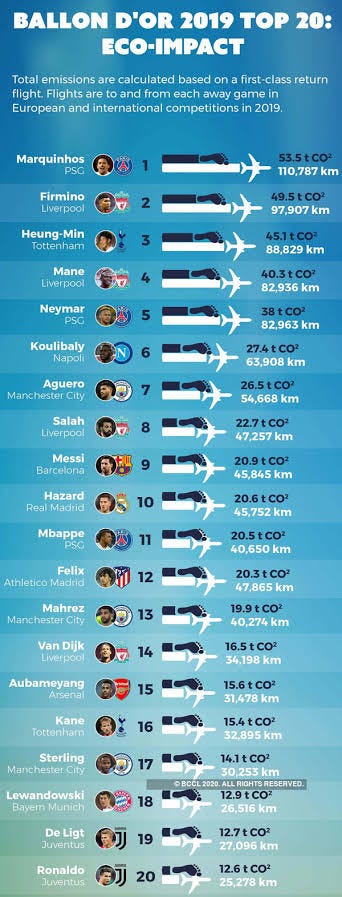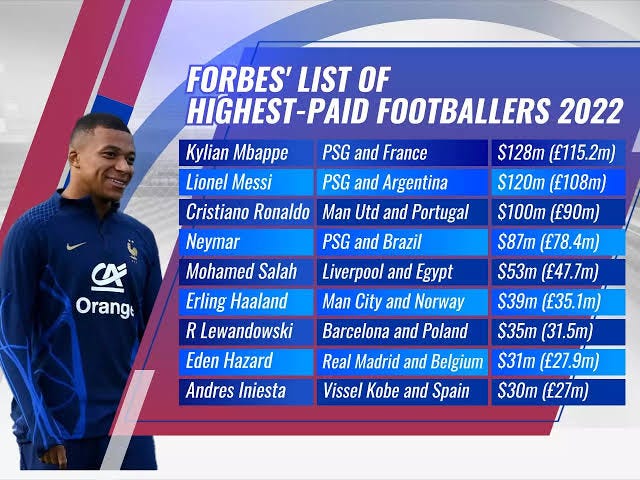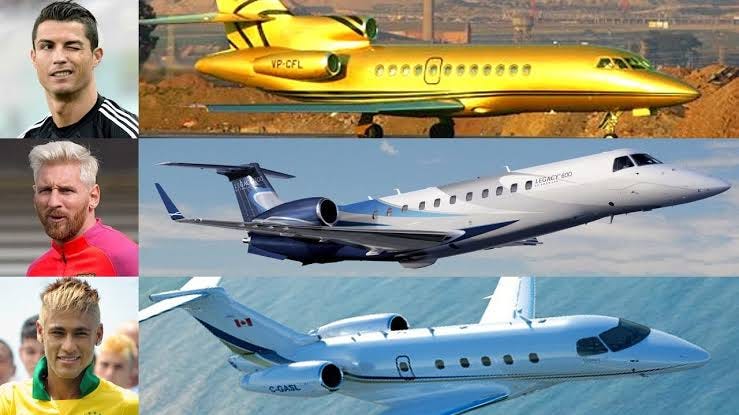Sure, Lionel Messi's carbon emissions from private jet travels equal amount of a French citizen in 150 years, but he's not the only footballer involved
Robert Firmino's carbon footprint equals to 6 home emissions a year. Sadio's equals 43,949 pounds of coal. Son Hueng-min's is enough to charge 5,750,806 smartphones. Stars need to reduce footprints
Lionel Messi's trips by private jet, Credit, L'Equipe
Activists criticize Lionel Messi, the soccer superstar, for his usage of his private jet, which gave off 1,502 tonnes of CO2 in a three-month period between June and August this year, the amount an average French citizen would emit in 150 years, but other soccer stars also emit large amounts of carbon emissions. Paris Saint Germain’s Marcos Aoás Corrêa, known as Marquinhos, accounted for huge carbon emissions in 2019, recording 53.5 tonnes through 110,787 kilometer air miles.
Liverpool’s Robert Firmino air miles in the same year hit 97,907 kilometers, recording 53.5 tonnes of CO2, equal to six home energy use for a year. Sadio Mane’s air travels resulted in 40.2 tonnes of CO2, the same amount as 43,949 pounds of burned coal.
Emissions by footballers, Credit, Economic Times
Tottenham’s Son Heung-min’s jet travels led to the emission of 45.1 tonnes of CO2, which could be utilized to charge 5,750,806 smartphones. Paris Saint Germain’s Neymar clocked 82,936 kilometers in 2019, emitting 38 tonnes of CO2, while Cristiano Ronaldo would have to slash down his carbon emissions of 12.6 tonnes through air travel of 25,278 kilometers by 95% to help in bringing a halt to climate change.
Footballers in general need to slash down their emissions of carbon dioxide in air travels in order to help bring a halt to climate change, the same thing with teams. In the 2016/17 season, English Premiership clubs produced 1,134 tonnes of CO2 as a result of their travels, with transportation amounting for 61% of their carbon footprint. Most Ligue 1 clubs in France conduct their away trips through jets, with Paris Saint Germain using them the most, the least Montpellier, which sometimes carry out their away fixtures via road.
Kylian Mbappe earns $128 million for the present year before taxes and agent fees, collecting $110 million between his salary and his share of his signing-on bonus. Messi rakes in $120 million, $55 million from his deals off-field. Ronaldo, his great rival, earns $100 million, $60 million through lucrative deals with cryptocurrency companies and others.
Footballers earn so much due to the revenue increases in the sport all over the world. For instance, Manchester City earned the most in 2022 with $766 million, followed by Real Madrid ($761 million), Bayern Munich ($726 million), Manchester United (766.3 million), and Liverpool ($654). The top twenty clubs, all based in Europe, pulled in an average of $450 million in 2020 to 2021, the figure representing a marginal increase on 2019 to 2020.
Also, clubs secure earnings through different sponsorship deals. In 2018, Edward Woodward the chief executive of Manchester United secured different sponsorship deals for the club, all yielding a bewildering 235 million pounds, including 70 million pounds from Chevrolet. Real Madrid earns an equally staggering amount, with Emirates paying the club 70 million euro a year to fly its flag. Barcelona gets an annual sponsorship turnover of 231 million pounds, with Rakuten once giving it 58 million dollars a season to have its name on the club’s kit.
With clubs earning so much a season from companies wanting their names on their shirts and kits, and players earning lots of money from off and on-field activities, it translates to Messi, Ronaldo, and others earning mouth-watering salaries, with the top ten highest paid soccer players expected to collect record pretax earnings of $652 million this season, up 11% from last year’s $585 million. It also translates to jet purchases: Ronaldo flies a 20 million pounds Gulfstream G20, Messi a Gulfstream V jet, Neymar a Cessna Citation Sovereign.
However, this impacts on carbon emissions. The top twenty footballers nominated for the 2019 Ballon d’Or accounted for the production of 505 tonnes of emissions through frequent air travel. This reflects on teams too, as Mbappe and other Paris Saint Germain stars boarded a jet for Nantes, just 380 kilometers from Paris recently, and Arsene Wenger in 2012 choosing his side Arsenal to fly to an away match at Norwich City, a distance of a mere 100 kilometers.
Unfortunately, this escalates the number of private aviation flights. In the U.S. for instance, it rises 20% after the beginning of the pandemic, resulting in an increase of CO2 equivalent emissions by 23%. Researchers forecast increases in other ways, as a long-term scenario suggests that overall private air travel emissions will likely exceed 770 megatons of CO2 equivalent in the next three years. Still another sad story, as CO2 emissions from European private jet market increased by 31% between 2005 and 2019, faster than those from commercial aviation.
Sadly, the use of private jets shows five to 14 times more pollution than commercial aviation, and 50 times more pollution than trains, since private jets emit two tonnes of CO2 in just an hour. Private jets emit more than 33m tonnes of greenhouse gases, more than Denmark, and possess the ability to produce eight times more emissions per person than comparable movements on commercial carriers, with a study pegging the 2016 production of private jets’ carbon dioxide at 33.7 million metric tonnes
With the annual contributions of private jets to greenhouse gases pegged so high, it becomes understandable why critics frown at Paris Saint Germain taking a flight to Nantes from Paris, and why observers expressed bewilderment with Wenger over the 2012 flight to Norwich. It underscores concerns over the 20% rise of private aviation flights since the COVID-19 pandemic, especially when just 40 tonnes of CO2 emissions from flights equal to the burning of approximately 44,000 pounds of coal.
Regulators can cut the harm done by private jets through permitting the usage of electric aircraft powered by green hydrogen for private flights under 1,000 kilometers, as green hydrogen made with zero-emission electricity would reduce climate impacts dramatically. Also, owners of private jets should pay hefty fuel and ticket taxes, especially as aviation fuel comes cheaper than gasoline or fuel, primarily because it stays in a different tax bracket. With fuel tax imposed on private jets and the use of green hydrogen implemented, activists might find fewer need for raising eyebrows on Lionel Messi’s flights, since they will pose a lesser danger to the environment.
Further readings
Football must do more to tackle climate change: this is how clubs and fans can help. Read more here.
Climate change: the next game changer for sport and exercise psychology. Read more here.
How much environmental damage are top footballers causing? Read more here.
What to eat
Nigerian vegan diet










Somethings gotta be done, seems unfair all the work and effort we've been putting, just to be eclipsed by these private jets flights.